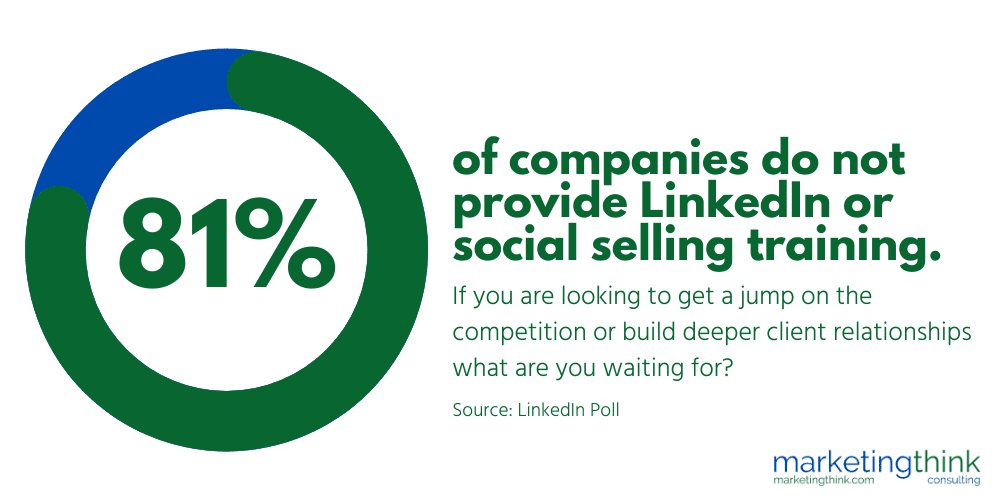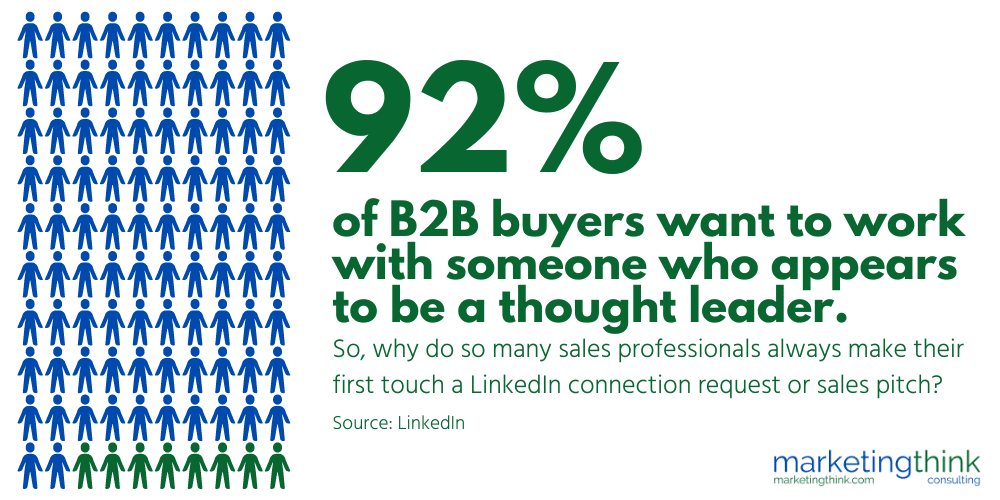Oh, look, another LinkedIn message from an uninformed and LinkedIn Navigator-using salesperson. How exciting! Because, you know, what all clients and prospects love is being bombarded with cold pitches from people they’ve never heard of, trying to sell something they don’t need. It’s not like decision-makers have anything better to do with their time. It’s time to learn a little about social selling, right?
But seriously, the sad truth is that far too many salespeople are just plain unskilled when attempting to secure a client’s attention. They’re like toddlers with power tools: they have no idea what they’re doing. In the process, they will just hurt themselves (and everyone else, like their company).
A fool with a tool is still a fool, right?
And don’t even get me started on LinkedIn Navigator. Sure, it can be a helpful tool if you know what you’re doing. But for most salespeople, it’s just a way to be even more annoying and intrusive. Congratulations, you’ve just ruined your brand and reputation in one fell swoop with a search-and-InMail exercise.
Leadership is Challenged — Should You or Shouldn’t You Use Social Media for Sales?
So what’s a CMO, CRO, or sales team leader to do? For starters, they should probably start assessing their team’s activity. Because if your salespeople are using LinkedIn Navigator like it’s a hammer when they really need a screwdriver, then something is seriously wrong.
And let’s be honest. The problem is more than just with LinkedIn Navigator. It’s with the salespeople themselves. They need to read the social selling manual (assuming there is one), engage in client discovery, and demonstrate their expertise. Presently, most jump in with a sales pitch and wonder why they’re getting ignored.
If you’re a buyer, you know the drill. You get a cold call or message from some random salesperson trying to sell you something you don’t need. And then they wonder why you’re not interested. It’s like they have no idea what they’re doing.
But hey, at least there’s a silver lining. We can all take screenshots of these terrible pitches and use them as examples of what not to do in our sales activity. It’s like a “wall of shame” for clueless salespeople.
A Sales Professional Untrained in Social Media Skills is Bad for Business
Let’s face it, a salesperson unskilled in social media is like a mosquito in your bedroom at night. You can tolerate them for a bit, but eventually, they will drive you insane.
But when it comes to social media, an untrained salesperson is like a wrecking ball to your business. HubSpot says that 73% of B2B buyers prefer to work with salespeople who use social media as part of their sales process. So, if your sales team needs to be more social media literate, they should pack up, go home, and learn the rules of the road.
And let’s remember the damage that can be done by a salesperson making a terrible first impression. LinkedIn reports that 94% of B2B buyers research social media before purchasing. If your sales team is cold-calling without first warming up potential buyers on social media, they might as well be throwing their sales pitch into the void.

So, if you want your sales team to avoid the fate of Willy Loman, it’s time to get them up to speed on social selling. Because in the sales world, if you’re not on social media, you might as well not exist. If you’re a sales manager, CRO, or company that relies on salespeople to connect with customers, here’s a handy list of signs that your salespeople could be better.
11 Signs a Sales Professional Is Not Using Social Selling
- First Contacts Lacking Personalization: If one of your salesperson’s LinkedIn InMail or direct messages looks like a generic message you could send to anyone, it’s a sign that they must put in more effort to personalize their approach. Come on. This is not rocket science for your sales professionals. Just coach them to take a few minutes to check out the target’s profile and reference something you have in common. It’s called being human.
- There’s No Reference of a Prior Relationship: When a sales professional has no prior relationship with their target, they miss out on an opportunity to connect. It’s like trying to hit a home run without warming up first. A little bit of engagement goes a long way. They need to comment on a post or two, join a LinkedIn group or mention a mutual connection or interest. These are all easy ways to create a sense of familiarity before reaching out.
- The Sales Professional is Not Active on Social Media: If a salesperson is a ghost on social media, it’s a sign that they must step up their sales game with social selling. In today’s world, do you even exist if you’re not on social media? Your team must show that they know their stuff by sharing posts and articles on LinkedIn. It’s pretty easy. And if you need to learn how to do it, just Google it. Seriously, it’s not rocket science. However, too many need to learn the basics of posting on LinkedIn. And with 75% of B2B buyers using social media to make buying decisions, you need to play to win, says LinkedIn.
- There is No Evidence of Industry Knowledge: When a sales professional has yet to learn what is happening in your client’s industry or can’t even grasp their business needs, it’s a sign that they’re not the brightest crayon in the box. Why would you want a seller who doesn’t know the landscape to try to sell landscape services? Have you heard of Google or LinkedIn? Time to get your team to do some research or at least read an article or two from industry experts. Just find a Wall Street Journal article and provide your point of view!
- The Client’s LinkedIn Profile Lacks of Engagement by the Sales Professional: If a salesperson is a ghost on social media and doesn’t bother to like, comment, or engage with your clients’ posts, it’s a sign that they’re probably a hermit on a hill. But seriously, social media is the new water cooler. You need to get your sales team to make small talk with your clients online to make significant brownie points. It’s time for them to start building relationships beyond the sales pitch and get on your client’s radar.

- Pushy Sales Tactics Are Employed: Ah, the pushy salesperson. You know, the type who thinks a high-pressure sales pitch and a “buy now or never” ultimatum are the best ways to close a deal. Newsflash, it’s not. If your sales team uses these tactics, it’s a sign that they have yet to use LinkedIn and other resources to help their clients frame their buying questions. They’re just trying to close the sale before they know what the client needs. Talk about putting the cart before the horse. Why not sprinkle in some social media onto your sales strategy, especially with 78% of those using it outselling their peers who don’t, says LinkedIn.
- Communication Does Not Provide Value: If that’s not bad enough, some of your salespeople don’t even bother providing any value or insights into their client’s industry or business needs. Really? You expect someone to respond when they are not receiving any questions or information that makes them go, “Hmmm?” 92% of B2B buyers want to work with someone considered a thought leader, reports LinkedIn. So, come on, sales leader. Your team should use LinkedIn’s tools to position themselves as smart, helpful, and better than your competition. You should see some of your competitive salespeople. It’s not that hard to jump to the head of the class. Otherwise, you’re just wasting everyone’s time.
- There is No Follow-Up — Even on Social Media: If a salesperson can’t be bothered to follow up with a client after a meeting or initial contact, they’re probably not interested in building a relationship. Come on. They should give a LinkedIn like or comment to show they are paying attention to the client.
- Lack of Social Proof of Salesperson Expertise on Their LinkedIn Profile: Don’t get me started on the lack of social proof. Suppose anyone on a sales team needs to provide testimonials or recommendations. In that case, it’s like they’re saying, “I’m not good at my job, but trust me anyway.” Suppose the salesperson needs social proof in their LinkedIn Featured section, such as testimonials, recommendations, or callouts. In that case, it’s a sign that they are not using their LinkedIn profile to build credibility and trust.
- The Salesperson Does Not Use LinkedIn to Do Their Homework: Remember the salespeople who don’t do their homework? They come in guns blazing with their perfect solution but have yet to learn what your business even does. It’s like they’re hoping to sell ice to an Eskimo. More calls like this, and their business will be iced!
- The Sales Professional Doesn’t Walk the Talk: Salespeople are the face of the company, so they need to optimize their LinkedIn profile. Every detail matters, from their background image to providing social proof in the About, Experience, and Featured sections. Sales professionals need to be more active with their social media habits. Good advice is to put in the effort to make a good impression. LinkedIn is our reputation’s destination, so treat it with love, care, and attention, at least for the company you sell for. If you don’t believe it, LinkedIn reports sellers with a higher Social Selling Index (a 4-part LinkedIn score, which considers one’s profile) develop 45% more sales opportunities than those with a lower score.
If any of these sound familiar, then it’s time to step up your social selling enablement game. Because if your salespeople annoy your potential customers, you will get very little in return from them. And let’s face it. No one wants to be that guy.
Your Next Steps for Addressing Your Team’s Social Selling Skills Gap With Sales Enablement Through Social Media?
Did you know 81% of companies do not provide any LinkedIn (and likely social selling) training? We want to help you determine your social selling strategy, from competitive assessment to leveraging LinkedIn conversation and sales triggers. We’ve built these social media and social selling programs and SAP and Cognizant and want to share with you our proven ideas. If not an entire program, we can provide a one-day social selling boot camp or a 6-session social selling training curriculum. Reach out today and schedule time with Gerry Moran.

